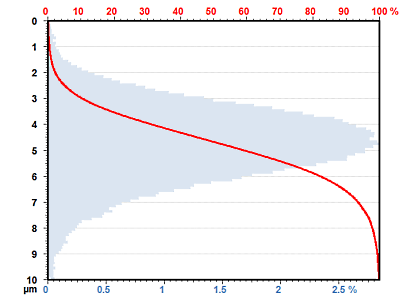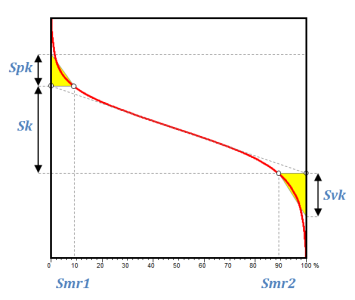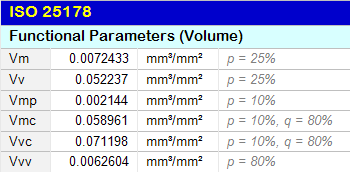Functional parameters are related to the distribution of heights and its cumulated curve (called the Abbott-Firestone curve), and are aimed at characterizing functional behavior of the surface, such as wear, lubrication, contact. They are global (field parameters) and can be seen as statistical parameters.
1. Bearing Ratio Parameters
Since bearing ratio parameters are related to the height distribution, they are easily extended to surfaces:
Smr, areal material ratio
Sdc, areal section height difference
Smc, inverse areal material ratio
Note the appearance of a new parameter, Smc, which simply provides the inverse value of the bearing ratio, as opposed to Sdc which is the difference between two Smc.
A new parameter is defined specifically for the characterisation of emerging peaks that play a role in contacts between two surfaces:

2. Sk Parameters
For a long time the mechanical engineering industry, and in particular the automotive industry, has tried to find ways of optimising parameters and filtering methods in order to make them more effective and to improve their correlation with functional phenomena.
The functional characterisation of surface texture is of fundamental importance for all mechanical parts that are in contact with another part, in other words for all parts with the exception of parts that have an aspect-related function.
The first reflex was to reproduce for a surface the graphical study of functional parameters defined in the ISO 13565-2 standard, based upon the Rk, Rpk and Rvk parameters initially defined by the German automotive industry (DIN 4776/4777). For surfaces, their counterparts Sk, Spk, Svk, Smr1, Smr2, Sa1, Sa2 have been renamed in the last revision in Sk, Spk, Svk, Smrk1, Smrk2, Sak1 and Sak2 and are calculated in the same way as on profiles, with respect to the Abbott curve, itself calculated on the entire surface.
Nonetheless in due course the new volume parameters are expected to replace these functional parameters that were derived from profilometry standards.

Similarily, parameters defined in ISO 13565-3 have been extrapolated to surfaces with Spq, Svq and Smq.
3. Functional Indices
The European SurfStand project defined a set of functional indices making it possible to characterize surface zones involved in lubrication, wear and contact phenomena.
Sbi, surface bearing index characterizes, as Spk does, the upper zone of the surface involved in wear phenomena.
Sci, surface core fluid retention index characterizes the main void volume acting as a lubricant reserve.
Svi, surface valley fluid retention index characterizes, as Svk does, the void volume of the deepest valleys.
These parameters, despite their utility, only represent an intermediate step towards the definition of Volume parameters that further improve correlation with functional phenomena and are more relevant, while continuing to provide the support that has been provided by the functional indices. As a result, in the ISO 25178 standard, the functional indices have been superseded by Volume parameters.
4. Volume Parameters
These parameters represent an evolution of the functional indices and are defined, like the functional indices and the family of Sk parameters, with respect to the Abbott curve:

The parameters are defined with respect to two bearing ratio thresholds, set by default to 10% and 80%. Two material volume and two void volume parameters are defined:
Vmp, peak material volume
Vmc, core material volume
Vvc, core void volume
Vvv, valley void volume
These parameters are expressed in units of volume per unit of surface (ml/m2 or µm3/mm2).

Functional parameters are offered with the Advanced Topography optional module, and in MountainsMap® Premium.